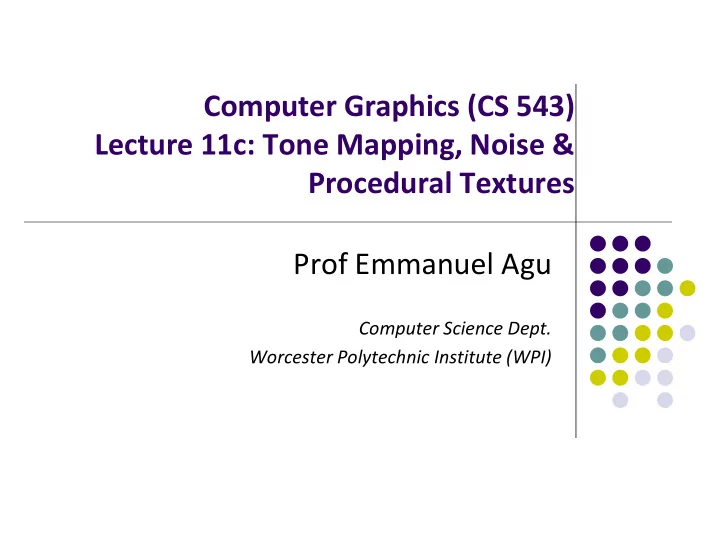

Computer Graphics (CS 543) Lecture 11c: Tone Mapping, Noise & Procedural Textures Prof Emmanuel Agu Computer Science Dept. Worcester Polytechnic Institute (WPI)
Tone Mapping
High Dynamic Range Sun’s brightness is about 60,000 lumens Dark areas of earth has brightness of 0 lumens Basically, world around us has range of 0 – 60,000 lumens (High Dynamic Range) However, monitor has ranges of colors between 0 – 255 (Low Dynamic Range) New file formats have been created for HDR images (wider ranges). (E.g. OpenEXR file format) 60,000 Lumens LDR HDR (Range: 256) 0 Lumens
High Dynamic Range Some scenes contain very bright + very dark areas Using uniform scaling factor to map actual intensity to displayed pixel intensity means: Either some areas are unexposed, or Some areas of picture are overexposed Under exposure Over exposure
Tone Mapping Technique for scaling intensities in real world images (e.g HDR images) to fit in displayable range Try to capture feeling of real scene: non-trivial Example: If coming out of dark tunnel, lights should seem bright General idea: apply different scaling factors to diffferent parts of the image Tone HDR Mapping (Range: 60,000) LDR (Range: 256)
Tone Mapping
Types of Tone Mapping Operators Global: Use same scaling factor for all pixels Local: Use different scaling factor for different parts of image Time-dependent: Scaling factor changes over time Time independent: Scaling factor does NOT change over time Real-time rendering usually does NOT implement local operators due to their complexity
Simple (Global) Tone Mapping Methods
Motion Blur Motion blur caused by exposing film to moving objects Motion blur: Blurring of samples taken over time (temporal) Makes fast moving scenes appear less jerky 30 fps + motion blur better than 60 fps + no motion blur
Motion Blur Basic idea is to average series of images over time Move object to set of positions occupied in a frame, blend resulting images together Can blur moving average of frames. E.g blur 8 images Velocity buffer: blur in screen space using velocity of objects
Depth of Field We can simulate a real camera In photographs, a range of pixels in focus Pixels outside this range are out of focus This effect is known as Depth of field
Lens Flare and Bloom Caused by lens of eye/camera when directed at light Halo – refraction of light by lens Ciliary Corona – Density fluctuations of lens Bloom – Scattering in lens, glow around light Halo, Bloom, Ciliary Corona – top to bottom
3D and Noise Textures
Solid 3D Texture Ref: Computer Graphics using OpenGL (Third edition) by Hill and Kelley, pg 648-656 Sometimes called 3D texture As if object is carved out of textured material. E.g. Wood, marble Texture: Each (x,y,z) point maps to (r,g,b) color f(x,y,z) -> (r,g,b)
Checkerboard Texture Imagine cubes of alternating color, each of dimension (S.x, S.y, S.z) placed next to each other A 3D texture for a checkerboard pattern can be written as: jump ( x , y , z ) = [( int )( x/S.x ) + ( int )( y/S.y ) + ( int )( z/S.z ))] % 2 3D texture lookup returns color 1 if jump = 0 and color 2 if jump = 1
Wood Texture Grain in log of wood due to concentric rings varying color As distance from some axis increases, functions jumps back and forth between 2 values This effect can be simulated with the modulo function rings(r) = (( int) r ) % 2 where 2 2 r x y Rings jumps between 0 and 1 as r increases from 0. The following texture jumps between D and D + A simple_wood(x, y, z) = D + A * rings(r/M)); Produces rings of thickness M that are concentric about z axis
Wood Texture (Contd) Can wobble rings by adding component that varies azimuth θ about the z axis rings(r/M + Ksin( θ/ N)) To add a twist to the wobbling grain: rings(r/M + Ksin( θ/ N + Bz))
Marble Grain of marble is quite chaotic Marble can be simulated by function that produces a “random value” at each (x,y,z) point in space Imagine each (x,y,z) point assigned with a random value. E.g. (2,2,1) = 0.7341 Random values could be stored in massive lookup table. Typically generated on the fly
Turbulence M 1 1 k ( , , , ) ( 2 , , , , ) turb s x y z noise s x y z k 2 2 k 0
Marble Texture General idea: give the marble’s veins smoothly fluctuating behavior (e.g. in z direction) Perturb the veins using turb( ) function For instance, start with texture that is constant in x and y, smoothly varying in z marble(x, y, z) = undulate(sin(z)); Above function is too regular Modulate sin( ) argument with some turbulence marble ( x , y , z ) = undulate ( sin ( z + A turb (s, x , y , z )));
Marble Texture (Contd) marble ( x , y , z ) = undulate ( sin ( z + A turb (s, x , y , z ))); Parameter s makes turbulence vary more or less rapidly at different points Parameter A changes amount of perturbation Example: g spline (sin(2 z A turb (5, x , y , z ))) A = 6 A = 1 A = 3
References Interactive Computer Graphics (6 th edition), Angel and Shreiner Computer Graphics using OpenGL (3 rd edition), Hill and Kelley Real Time Rendering by Akenine-Moller, Haines and Hoffman
Recommend
More recommend